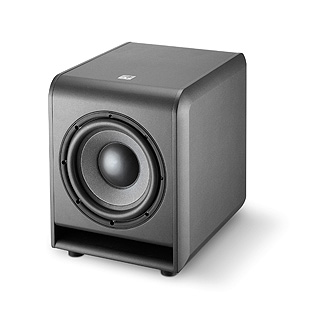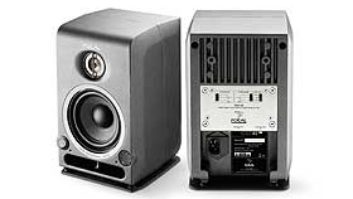
The CMS SUB features polarity reverse, rotary phase adjustment, lowpass filter, remote mute gain and gain control.
The CMS SUB is Focal’s companion subwoofer to its CMS line of active pro audio monitors. For this test, I paired the CMS 65s with the CMS SUB. The CMS SUB’s light, rigid, 11-inch Polyglass cone woofer is made from a layer of hollow glass spheres on top of a paper cone. This sturdy, 50-pound, 17.1×14.4×17.3-inch (HxWxD) sub has a 300-watt amp producing 113dB SPL peaks at three feet, with a response that is accurate within ±3 dB from 30 to 250 Hz. Left and right ins/outs and an independent LFE input are on balanced XLRs. Controls include continuously variable rotary level adjustment, polarity reverse, variable phase control, mute switch, mute footswitch port and variable lowpass adjustment.
GET SMAART
I used Rational Acoustics’ Smaart software to align the CMS SUB with the CMS 65s. I first mounted the L/R monitors on a sturdy I-beam shelf over the meter bridge of an SSL 4056 E/G Series console. The medium-sized control room has a large window at the front and bass traps at the back. Due to a lack of options from traffic and space, I placed the CMS SUB under the back of the console with the speaker firing at the listening position and removed the protective metal screen. I connected the console’s control room outs into the CMS SUB and then out into the CMS 65s. To start, I set the sub’s lowpass to 90 Hz, set the level at 10 o’clock and engaged the mute, leaving the phase and polarity switches alone until I got Smaart involved. The CMS 65s have 45/60/90Hz highpass filter options, plus desktop shelf and high/low-shelf options. I set the CMS 65s at 90 Hz and left everything else flat.
The crossover points looked close but the phase was significantly misaligned compared to the CMS 65 traces. The speakers were tested one at a time and traces stored. The traces showed a considerable dip at 700 Hz, so the speakers were removed from the console and placed on Sound Anchor stands behind the desk at the same height to reduce the dip by taking the console’s reflection out of play, which did improve the response. The L/R speaker positions and stands were adjusted until the Smaart traces were in near-perfect alignment. (Go to the “Mix Media” section at mixonline.com to see Smaart traces.) Next, the CMS SUB was isolated and traces were stored in Smaart. The crossover points looked close, but the phase was significantly misaligned as compared to the CMS 65 traces. The variable phase control and lowpass filter on the CMS SUB brought phase into alignment and the system was dialed in. It’s important to use Smaart or something similar to set up a control room in this fashion. The difference—before and after Smaart—is substantial.
FINDING BOTTOM
I used the Focal 2.1 system for playback of pre-mastered material and during tracking sessions to analog tape and Pro Tools. I was looking for a seamless transition between the sub’s extended bottom and the near-fields, and I found it. There were times when I’d have to walk back and raise or lower the overall volume of the sub, depending on my application. For instance, for tracking I’d lower the volume of the sub until I was satisfied that the bottom end sounded realistic. But during listening tests from various prerecorded and mastered sources, I found I needed a bit more bottom to flesh out the system in the room. The overall balance of any subwoofer is highly subjective, but the beauty of this system is that you can adjust the LF depending on your sources. In all cases, I had a centered, cohesive sonic picture instead of two speakers with a thundering rhino under the desk. I loved the additional bottom on my bass, kick drum and tom tracks. The low end was solid, punchy—never over the top or muddy.
I also auditioned the system for various engineers whose ears I trust. Seeking uncolored first impressions, I purposely did these “guest” listening sessions with as little intrusion of my opinion as possible. All of the engineers confirmed my findings, remarking how well the sub integrated with the near-fields.
SHOULD YOU GO LOW?
Honestly, I’m not a sub lover, having been disappointed with past experiences. But after living with this setup for an extended period, both with and without the sub, I would strongly recommend it in a situation where the room is big enough to handle the extended low end. In my tests, the bottom was punchy and full without being overbearing. I would like a means of remotely altering the sub gain. The remote mute switch is handy, but not as useful as a remote gain control. That said, Focal has created an able and great-sounding sub that pairs perfectly with its CMS line of speakers.
Kevin Becka is
Mix
’s technical editor.

Speaker on meter bridge (brown) vs. on stand (white)

In the top display, you can see how the sub unaligned (green) looks vs. the sub aligned (pink) in relation to the left speaker (purple). Adjusting the sub’s phase with the main speakers makes the entire 2.1 array work as a single unit rather than sounding like the subwoofer is a separately discernible component.

Click on the Product Summary box above to view the Focal CMS Sub product page.







